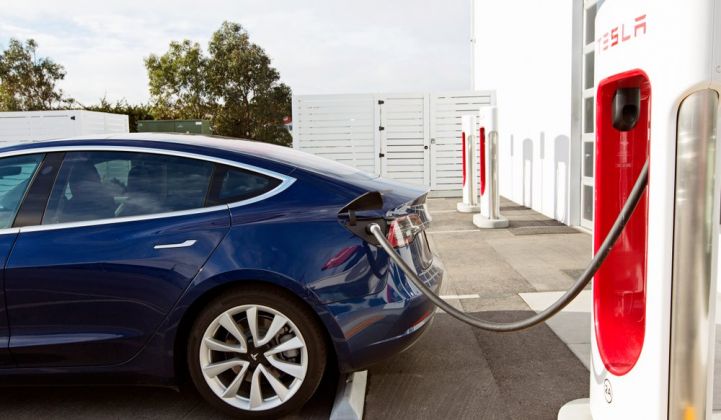Elon Musk told shareholders Tuesday that Tesla should hit its long-promised production target for the Model 3 sedan of 5,000 units per week by the end of June.
The comments came during Tesla’s 2018 annual shareholder meeting at the Computer History Museum in Mountain View, California.
“It’s quite likely that we will achieve a 5,000-car week by the end of this month,” said Musk.
Musk’s confidence in hitting the Model 3 production target is based on recent upgrades at Tesla’s Fremont, California manufacturing facility.
Construction on a third general assembly line in Fremont started two weeks ago. The first Model 3 has already entered that line.
“The biggest constraint on output is general assembly,” said Musk. Tesla could have produced 5,000 Model 3s per week with the original two production lines, he said, but with the addition of the third, “I’m highly confident that we can exceed 5,000 units per week.”
Contrary to recent press reports asking if Tesla might be abandoning the mass market and what happened to the $35,000 Model 3, Musk assured investors Tesla has not given up on plans to manufacture the base-level version of the car.
“We will definitely offer a $35,000 version of the Model 3,” said Musk. “We will definitely honor that obligation. We would do so right now if it was physically possible.”
By the end of the year, he said, Tesla should be able to manufacture the Model 3 with the smaller battery pack. Volume production of the $35,000 Model 3 would begin in Q1 2019.
Wait times for the Model 3 depend on where you are in the world and the configuration of the car chosen. Ordered today, wait times for Model 3s with the existing configuration would be three or four months, said Musk. The wait for the right-hand-drive version, meanwhile, could be up to 15 months.
Musk repeated Tesla’s contention that should Model 3 production ramp up as expected, profitability will follow.
“It’s really looking like we’re going to have positive GAAP net income next quarter, as well as positive cash flow, in Q3 and Q4,” he said. “As I said before, we do not expect to need to raise any incremental debt or equity.”
Tesla plans to unveil the Model Y crossover SUV in March 2019, with production launching in the first half of 2020.
Shareholders reject efforts to increase independent oversight of Tesla
Coming into the meeting there was the possibility — albeit small — that shareholders might not re-elect three board members, including Kimbal Musk, Elon’s brother, nor allow Elon Musk to retain his dual CEO and board chairman titles.
Tesla’s board had recommended that shareholders re-elect all three board members, as well as reject a shareholder proposal that would have required the board chairman be an independent director.
According to Tesla, shareholders voted to re-elect the three board members and to permit Musk to continue wearing both hats by a supermajority vote.
Speaking before the results were announced, CtW Investment Group’s Steve Diamond raised concerns about Tesla’s corporate governance.
The shareholders he represents want Tesla to succeed, he said, “but the current board is an obstacle, not an aid, to these goals.” He had urged shareholders not to re-elect the slate of incumbent board members.
“We did not think these individuals are a credible, independent voice for shareholders. Their lack of significant auto industry experience and human capital management experience are only their most obvious deficits,” he said.
“We are also concerned about whether these highly paid directors can help the CEO focus on solving the serious financial, production, and labor relations problems now facing Tesla," he added.
Next-generation Supercharger on the way, 1 GWh storage deployed globally
Tesla continues to expand its Supercharger network, with just under 10,000 units deployed worldwide. The goal, said Musk, is to be able to go almost anywhere on earth using the Tesla Supercharger system.
A next-generation Supercharger will go into production by the end of 2018. When that generation III Supercharger launches, said Musk, “we’re going to accelerate Supercharger expansion even more.”
Tesla also announced it has deployed 1 gigawatt-hour of energy storage globally. In less than one year from the date of the 2018 shareholder meeting, said Musk, Tesla will have installed its next 1 gigawatt-hour.
“The rate of stationary storage deployment is going to grow exponentially,” he added. “Next quarter, at the Gigafactory, we expect to make more battery capacity than all other EVs combined worldwide, including China.”
The aggressive energy storage deployment is possible because of the massive scale of the Gigafactory. Still just one-third complete, it already takes two hours to walk the length of the factory floor, according to Musk.
Construction will continue on the Gigafactory for at least the next four or five years, he said, and it “will be by far the biggest building in the world.”
Tesla will eventually build 10 or 12 Gigafactories worldwide, said Musk, with the goal of localizing production at least to the continent level.
Tesla will announce as soon as next month a combined battery production and vehicle assembly Gigafactory in Shanghai, China. A Europe Gigafactory announcement may come by the end of the year, with the location as of now undecided.




